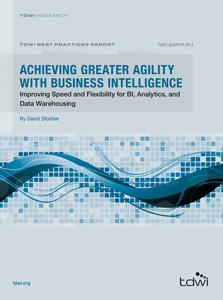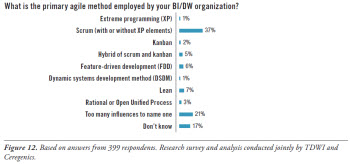 View online: tdwi.org/flashpoint
View online: tdwi.org/flashpoint





July 11, 2013
ANNOUNCEMENTS
NEW TDWI E-Book:
Unified Data Architecture
NEW TDWI E-Book:
Investigative Analytics: The New BI Frontier
NEW TDWI Checklist Report:
Agile Data Quality: Speed, Flexibility, and Business Alignment for Improving Data
NEW TDWI Best Practices Report:
Data Visualization and Discovery for Better Business Decisions
CONTENTS

Three Best Practices to Developing a BI Strategy

Managing Ethics in Business Intelligence

Tracking Adoption of Agile Methods for BI/DW

Mistake: Thinking Agile Is Just a Developer Thing

See what's
current in TDWI Education, Events, Webinars,
and Marketplace

Three Best Practices to Developing
a BI Strategy
Troy Hiltbrand
Idaho National Laboratory
Topics:
Program Management
It has been said that, without a strategy, an organization is like a ship without a rudder, going in circles and never getting anywhere. This happens to many organizations that take on the challenge of implementing business intelligence (BI). They hinge their success on hard work and the right technology, but without a clearly defined strategy to guide them, they end up going in circles and never achieve their desired success.
A strategy is not simply about choosing the right technology. Confusion exists across the industry because many large BI vendors focus on how their product suites are the “silver bullet” that will solve an organization’s challenges. Without a strategic objective in sight, the technology cannot have the intended impact on your organization’s success.
An effective strategy focuses on three key aspects of a BI program: the what, the who, and the how. It is similar in importance--but very different from--a BI project plan. The strategy defines the target state, and the project plan lays out the tactical execution of activities moving your enterprise toward defined strategic goals. Although framing and executing projects is important to success, it will fail to deliver value if your strategy is missing or incomplete.
What
The first facet of an effective BI strategy is to define what represents success for the initiative. This includes understanding the current state of your organization, its needs, and its overall strategy. An organization focusing on being the low-cost provider of goods and services in its market will have a significantly different purpose for its BI initiative than one emphasizing innovation and being first to market with its product or service. Success of the BI initiative is ultimately tied directly to your organization achieving its strategic targets.
Your BI strategy must qualify and quantify the organizational benefits you want to realize. A BI project that achieves only moderate technological results, but is meaningful to your organization’s strategy, is deemed more effective than a BI project that implements the perfect technological solution with targets irrelevant to your business.
Who
Next, your strategy needs to address who will sponsor the initiative and who will participate. BI initiatives sponsored by your CIO and done completely within your information technology (IT) department are significantly less likely to succeed than are partnerships between the key business units and IT. A collaborative partnership is key to your organization’s success.
The strategy needs to address who will champion the initiative as well as who will execute the work. As information becomes increasingly more important to your organization’s success, key personnel in the areas of business requirements, data integration, and analytics and visualization are essential. Labor forecasts predict significant shortages in these areas due to increased demand, so it is vital to identify how the project will be staffed and how the talent pipeline will be developed in areas of weakness.
Your team needs to be defined in terms of the skills and capabilities necessary for your success. Does your organization have sufficient personnel with these skills? If success requires predictive and prescriptive analytics, does your team have sufficient knowledge of the algorithms and methods in the area of data science? If success requires the management of big data, is your team knowledgeable about the leading-edge platforms and concepts supporting big data? Is business-domain knowledge adequate (or being properly addressed) to ensure delivery of valuable knowledge and wisdom for decision making, and not merely data? If not, your strategy needs to address how these gaps will be filled.
How
The third fundamental of your BI strategy is to understand how the initiative will proceed. This extends beyond your tactical plan. It addresses which major subject areas the BI initiative will tackle, in what order, and what deliverables will be produced to provide value to the organization in achieving your higher-level business strategy.
In lieu of focusing only on short-term deliverables, the strategy takes a multiyear perspective. It must identify the long-term future of the BI program, including the initial implementation of the technology and data warehouse, as well as the ongoing support and development of an enterprise analytics competency to effectively use the technology to drive business results.
To Your Success
If done correctly, a business intelligence strategy can be a differentiator between success and wasted investment. Taking time to clearly define and delineate your business intelligence strategy is paramount to delivering organizational value.
Troy Hiltbrand is the program lead for IT Strategy and Enterprise Architecture at the Idaho National Laboratory and an adjunct professor at Idaho State University.

Managing Ethics in Business Intelligence
James B. Thomann and David L. Wells
Ethics is the challenge of distinguishing right from wrong and good from bad. It is challenging because right and good are not always clear. Business intelligence raises many new ethical questions about how we collect intelligence and how we use that intelligence. We are approaching an era in which every BI program will need to actively manage ethics. More data, more kinds of data, and advanced analysis of data often conflict with concerns of data privacy, security, anonymity, and ownership. Resolving these conflicts requires acknowledgment, discussion, and the hard work of defining ethics-based policies and creating a culture of ethical conduct.
This article frames the BI ethics challenge by defining ethical questions as distinct from moral and legal questions and by positioning ethical questions in the context of BI. It describes ethical questions and 10 principles of data ethics. Building on this foundation, it describes practices and techniques to guide ethical conduct, to define the business case for ethics management, and to take practical steps to manage BI ethics.
Read the full article and more: Download Business Intelligence Journal, Vol. 18, No. 2



Highlight of key findings from TDWI's wide variety of research
Tracking Adoption of Agile Methods for BI/DW
Scrum is easiest, but hybrids find appeal. Scrum is the most prevalent agile method; 37% of respondents indicated that this is what they use (see Figure 12). Scrum is regarded as easy to learn and simple for a facilitator to keep on track. In addition, since scrum is widely used, it is easier to find professionals with experience to share. However, the specific challenges of BI/DW, which can include the need for longer cycles, make it important for organizations to find scrum masters who have experience not only with the agile methods but also with BI/DW development. Generic agile approaches can put too much pressure on teams to promote code into release pools after every sprint. Organizations experienced with BI/DW agile development often find that they need some pipelining of work functions rather than strict scrum cycles so that team members have full sprints to address specific requirements.
Figure 12 lists the level of implementation of other types of agile methods. Beyond “too many influences to name one” (21%)--and indeed, many organizations use multiple methods--the next highest percentage of respondents say they use the lean method (7%), an established but more rigid approach than scrum based on the Toyota Production System. Lean can be useful to organizations that have been successful with scrum but are interested in creating more structure and repeatability around certain processes. Only 2% are implementing kanban, another method with its origins in Toyota for scheduling production to meet lean and just-in-time objectives.
Read the full report: Download Achieving Greater Agility with Business Intelligence



FlashPoint Rx prescribes a "Mistake to Avoid" for business intelligence and data warehousing professionals.
Mistake: Thinking Agile Is Just a Developer Thing
Ken Collier, Ph.D.
Agile BI is often perceived by management as a process to be imposed upon the BI team. I was dismayed once to hear an IT executive say, “To be more responsive, we need to increase the productivity of our BI group, so we are sending the functional team leads to agile BI training so they can bring agile back to their teams.”
This myopic perspective by leaders is surprisingly pervasive. The ill-conceived reasoning goes something like this: BI teams routinely fail to meet business user expectations. Business users have lost faith in the ability of the BI team to deliver anything of value. Something must be wrong with our process, and agile BI sounds like a way to get more done faster. Therefore, our BI teams should become agile.
This reasoning is flawed in at least two ways. First, it assumes the BI team is not already working as hard as possible and that there is more productivity to milk out of the team. Second, it assumes that agile is like a magic wand that, when waved over the BI team, will result in greater team capacity.
Agile BI is simple to understand but difficult to do well. It requires commitment and cultural change from management, business users, and team members. Moreover, it requires a change in mindset by the customer, management, and technical communities. Isolating responsibility for agile BI to the technical team is a surefire way to experience poor results.
Read the full issue: Download Ten Mistakes to Avoid In an Agile BI Transformation (Q2 2013)




